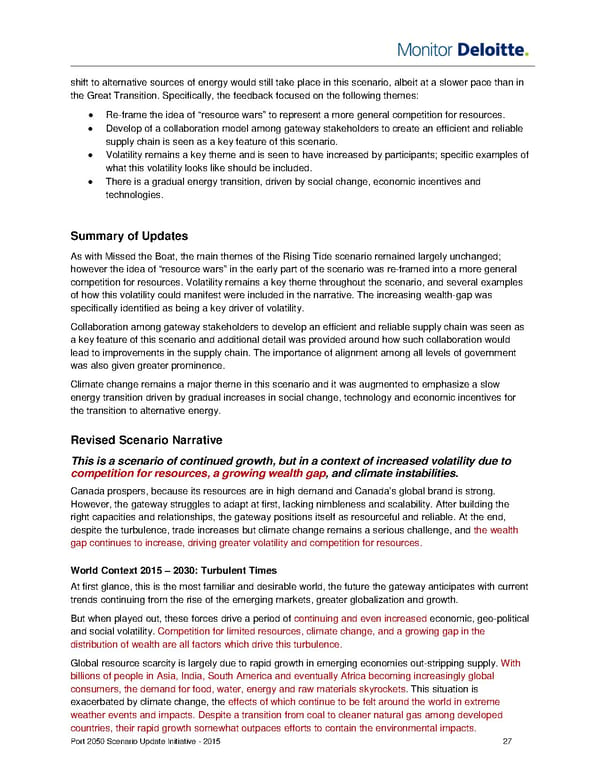shift to alternative sources of energy would still take place in this scenario, albeit at a slower pace than in the Great Transition. Specifically, the feedback focused on the following themes: • Re-frame the idea of “resource wars” to represent a more general competition for resources. • Develop of a collaboration model among gateway stakeholders to create an efficient and reliable supply chain is seen as a key feature of this scenario. • Volatility remains a key theme and is seen to have increased by participants; specific examples of what this volatility looks like should be included. • There is a gradual energy transition, driven by social change, economic incentives and technologies. Summary of Updates As with Missed the Boat, the main themes of the Rising Tide scenario remained largely unchanged; however the idea of “resource wars” in the early part of the scenario was re-framed into a more general competition for resources. Volatility remains a key theme throughout the scenario, and several examples of how this volatility could manifest were included in the narrative. The increasing wealth-gap was specifically identified as being a key driver of volatility. Collaboration among gateway stakeholders to develop an efficient and reliable supply chain was seen as a key feature of this scenario and additional detail was provided around how such collaboration would lead to improvements in the supply chain. The importance of alignment among all levels of government was also given greater prominence. Climate change remains a major theme in this scenario and it was augmented to emphasize a slow energy transition driven by gradual increases in social change, technology and economic incentives for the transition to alternative energy. Revised Scenario Narrative This is a scenario of continued growth, but in a context of increased volatility due to competition for resources, a growing wealth gap, and climate instabilities. Canada prospers, because its resources are in high demand and Canada’s global brand is strong. However, the gateway struggles to adapt at first, lacking nimbleness and scalability. After building the right capacities and relationships, the gateway positions itself as resourceful and reliable. At the end, despite the turbulence, trade increases but climate change remains a serious challenge, and the wealth gap continues to increase, driving greater volatility and competition for resources. World Context 2015 – 2030: Turbulent Times At first glance, this is the most familiar and desirable world, the future the gateway anticipates with current trends continuing from the rise of the emerging markets, greater globalization and growth. But when played out, these forces drive a period of continuing and even increased economic, geo-political and social volatility. Competition for limited resources, climate change, and a growing gap in the distribution of wealth are all factors which drive this turbulence. Global resource scarcity is largely due to rapid growth in emerging economies out-stripping supply. With billions of people in Asia, India, South America and eventually Africa becoming increasingly global consumers, the demand for food, water, energy and raw materials skyrockets. This situation is exacerbated by climate change, the effects of which continue to be felt around the world in extreme weather events and impacts. Despite a transition from coal to cleaner natural gas among developed countries, their rapid growth somewhat outpaces efforts to contain the environmental impacts. Port 2050 Scenario Update Initiative - 2015 27
 Monitor Deloitte - Final Report Page 28 Page 30
Monitor Deloitte - Final Report Page 28 Page 30